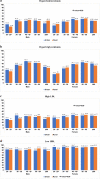NDSP 05: Prevalence and pattern of dyslipidemia in urban and rural areas of Pakistan; a sub analysis from second National Diabetes Survey of Pakistan (NDSP) 2016-2017
- PMID: 33520835
- PMCID: PMC7843689
- DOI: 10.1007/s40200-020-00631-z
NDSP 05: Prevalence and pattern of dyslipidemia in urban and rural areas of Pakistan; a sub analysis from second National Diabetes Survey of Pakistan (NDSP) 2016-2017
Abstract
Objectives: Dyslipidemia is a major risk issue for the development of cardiovascular disease. The aim of our study was to observe the pattern and prevalence of dyslipidemia in Pakistani population.
Methodology: This is a sub analysis of a population based second National Diabetes Survey of Pakistan (NDSP) 2016-2017 in adults aged 20 years or above, carried out from February 2016 to August 2017 across Pakistan. Multi stage sampling technique was used for the stratification of population, based on rural and urban domains. District wise clusters and sub clusters were selected i.e. 27 and 46 in number. Subjects, consented to participate were requested to come after an overnight fast for anthropometric measurements, oral glucose tolerance test and fasting lipid profile (except for subjects with self-reported diabetes). Dyslipidemia was identified using Adult Treatment Panel III guidelines.
Results: A total of 10,834 subjects (43.8% male and 56.2% female) having mean age of 43.8 ± 14.0 years, participated in the survey. Of the subjects studied, 39.3% had hypercholesterolemia, 48.9% had hypertriglyceridemia, 39.7% had high LDL-C levels while 83.9% men and 90% women had low HDL levels. High cholesterol and triglyceride levels were highest in 50-59 years age group, while high LDL and low HDL was most common in 40-49 years age group. Diabetes, obesity and hypertension were found to be the significant determinants for dyslipidemia.
Conclusion: Prevalence of dyslipidemia seems to be very high in Pakistan, necessitating an urgent call for early screening and effective management through lifestyle intervention and appropriate lipid lowering drugs to prevent this important cardiovascular risk factor.
Keywords: Dyslipidemia; Pakistan; Prevalence; Second NDSP.
© Springer Nature Switzerland AG 2020.
Conflict of interest statement
Conflict of interestThe authors declare that they have no conflicts of interest.
Figures
References
-
- Nishiyama Y, Otsuka T, Ueda M, Kimura K. Dyslipidemia should be associated with an increased risk of hypertension in a working-age Japanese male population. Stroke. 2016;47:ATP197.
LinkOut - more resources
Full Text Sources
Miscellaneous


